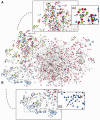Matching arthropod anatomy ontologies to the Hymenoptera Anatomy Ontology: results from a manual alignment
- PMID: 23303300
- PMCID: PMC3540420
- DOI: 10.1093/database/bas057
Matching arthropod anatomy ontologies to the Hymenoptera Anatomy Ontology: results from a manual alignment
Abstract
Matching is an important step for increasing interoperability between heterogeneous ontologies. Here, we present alignments we produced as domain experts, using a manual mapping process, between the Hymenoptera Anatomy Ontology and other existing arthropod anatomy ontologies (representing spiders, ticks, mosquitoes and Drosophila melanogaster). The resulting alignments contain from 43 to 368 mappings (correspondences), all derived from domain-expert input. Despite the many pairwise correspondences, only 11 correspondences were found in common between all ontologies, suggesting either major intrinsic differences between each ontology or gaps in representing each group's anatomy. Furthermore, we compare our findings with putative correspondences from Bioportal (derived from LOOM software) and summarize the results in a total evidence alignment. We briefly discuss characteristics of the ontologies and issues with the matching process.
Figures


References
-
- Ramírez MJ, Coddington JK, Maddison WP, et al. Linking of digital images to phylogenetic data matrices using a morphological ontology. Syst. Biol. 2007;56:283–294. - PubMed
-
- Topalis P, Tzavlaki C, Vestak K, et al. Anatomical ontologies of mosquitoes and ticks, and their web browsers in VectorBase. Insect Mol. Biol. 2008;17:87–89. - PubMed
-
- Drysdale R. Phenotypic data in FlyBase. Brief. Bioinform. 2001;2:68–80. - PubMed
Publication types
MeSH terms
LinkOut - more resources
Full Text Sources
Other Literature Sources

